Behind the Curtain
Designing angel wings. Rigging lights. Dyeing dress shoes. Here’s what it takes to stage a show at the new Booth Theatre.
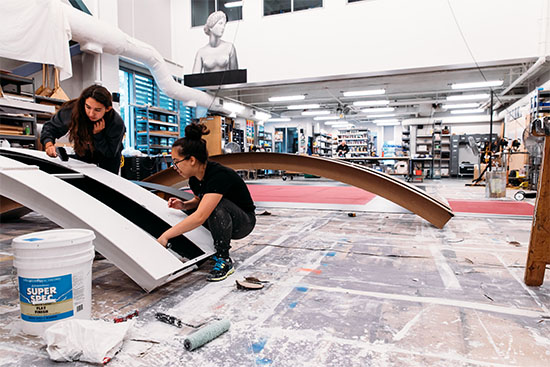
Photos by Natasha Moustache and Jason Kimball
Behind the Curtain
Designing angel wings. Rigging lights. Dyeing dress shoes. Here’s what it takes to stage a show at the new Booth Theatre.
The two-part Angels in America: A Gay Fantasia on National Themes is an intense production: during seven hours of total stage time, lead actors are also required to take on a couple of minor roles and help shuffle props during rapid scene shifts. Tony Kushner’s multi-award–winning exploration of AIDS in 1980s New York is the perfect showcase for the Joan & Edgar Booth Theatre, which was built as a fluid space—seats rise, trapdoors disappear, runways emerge. One moment it can be a traditional theater with an end stage, the next a theater in the round.
CFA staged Angels in America at Booth in October 2018, splitting the production’s two parts into consecutive runs with different directors and casts—though not sparing the actors multiple parts. A fortnight before opening night, CFA magazine was given exclusive behind-the-scenes access to watch the play take shape.
Stepping backstage at Booth is like peeking into Narnia. The black box of the theater is 21,000 square feet, but the theater complex itself is 75,000 square feet. Entire worlds emerge from behind almost every door: a mini millinery with mannequin heads, hats, and fabric; a hanger-like set design workshop full of whirring machine tools; rooms stuffed with wigs and clothes of every stripe. Some clash with noise, students and faculty swirling around each other as they build props or test lighting setups; others, like the classrooms that double as workshops (or is it vice versa?) for set and costume designers, charged with quiet concentration.
Scenery and Paint Shop
The double-height scenery and paint shop is big enough to accommodate the production of sets for two shows at the same time—even while another is being staged. Raw materials arrive on a loading dock and are milled down on-site, then shaped and assembled. A section of the space has a wooden floor to mimic the theater.
“Not only can we assemble scenery here,” says Johnny Kontogiannis (’02,’20), Booth’s production manager, “we can actually do a setup of the whole set. That way, we can see how it all goes together and work out the kinks right here.”
The theater complex also has classrooms and studios for scene designers. “A big part of our teaching is getting on our feet and doing,” says Kontogiannis. “Our ideal situation is to say to students, here’s a theater, here’s some money, go put on a show; then, we help guide it.”
Lighting and Sound Design
Booth’s ceiling holds a grid of nine lighting rigs. Each one can be moved independently, flying to the ground for lights to be hung, then set at different levels to alter the atmosphere or focus onstage.
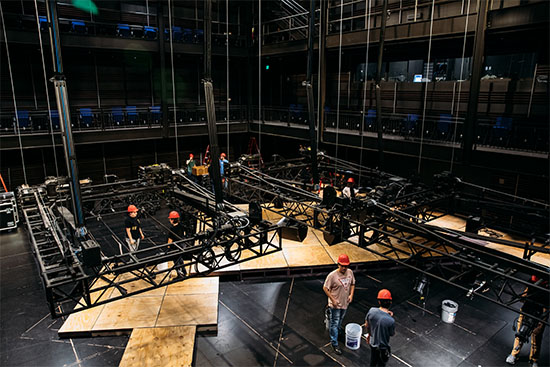
Kontogiannis calls the space a playground: “In a proscenium theater [a theater with a frame, or proscenium], you have a more defined relationship, you’re looking through a frame; here, you’re behind the proscenium and we’re inhabiting one space. That’s an important part of how we approach the storytelling—we’ve brought the audience into the space of the story.” Backstage, there’s a lighting and sound design lab for students to practice.
Costume Shop
The costume shop does double duty. During the day, a partition is pulled across the room: on one side, faculty teach classes; on the other, students work on their projects for upcoming shows. At night, the entire room is dedicated to production preparation. “We teach it and then we make it,” says Kontogiannis. Small side rooms have space for actors to step in for fittings. All the students can also head into the lighting and sound design lab to see how a costume looks when plunged into the spotlight. “A student will take the thing they’ve learned and implement it very quickly,” says Kontogiannis.
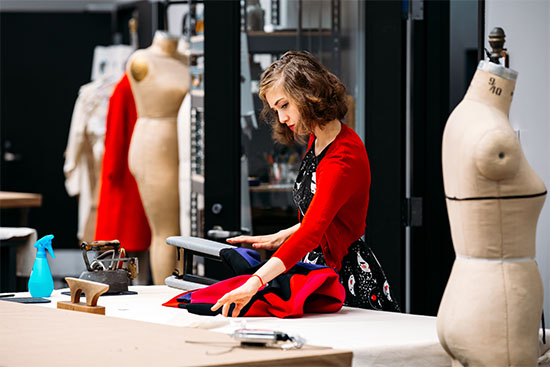
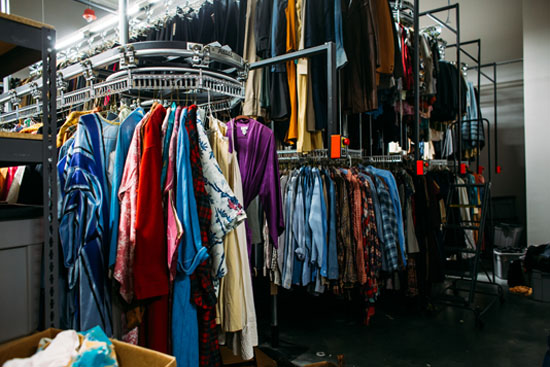
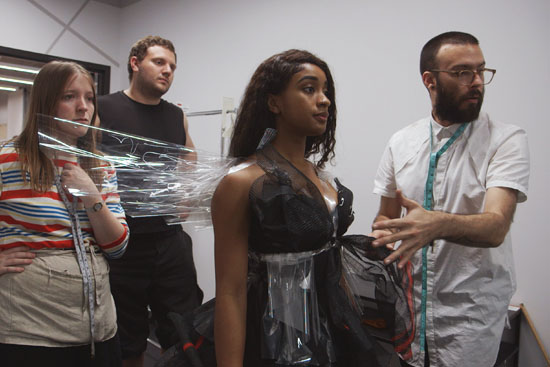
“Imagine your grandmother’s attic,” says Kontogiannis of Booth’s costume shop, stocked with props and costumes. In one room, tables, couches, phones, typewriters, and every conceivable kind of knickknack fill shelves and storage bins; in another, a two-story dry-cleaning storage system holds clothes sorted by gender and period.
Kontogiannis, who formerly taught at Ithaca College and has also worked on Broadway, admits it would have been easy for BU to have stuck it all in a suburban warehouse, but says there’s something compelling about being able to browse the rooms, to touch the objects and be inspired. “We actually think of these rooms more as libraries than storage. You could click through clothes on a computer, but it’s not the same as feeling them.” If a costume isn’t quite right, students can also dye or tailor them to fit the actor or time period.
